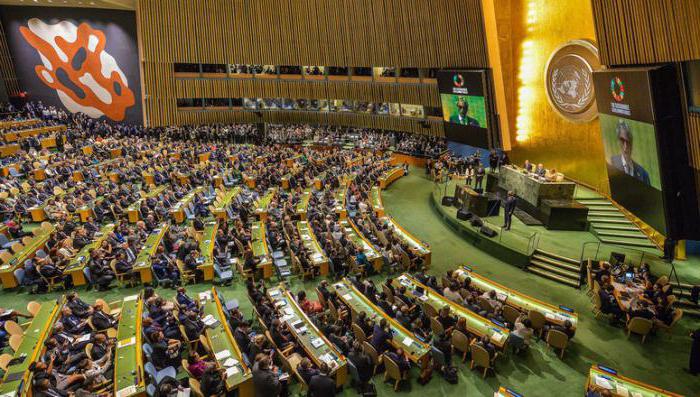Responsibility is a key concept in law. It is necessary for the constant maintenance of public order and justice. Thanks to the institution of liability and sanctions, any disputes can be concluded in a peaceful and safe manner. Our article will talk about the types of liability in international law.
Concept of responsibility
As you know, a legal norm has a three-member structure. It contains a hypothesis, disposition and sanction. A hypothesis is called certain life circumstances. In each life situation, it is necessary to observe the rules of behavior that are established in the disposition. For violation of such rules, a person may be sanctioned - a punishment.
The concept of liability is closely related to the third element of law, sanction. The company has certain obligations, for each of which is responsible. This is characteristic of both national and international law.
At the interstate level, responsibility is established for countries, large public organizations and prominent world figures. There are several types of liability in international law. Each species has its own specifics.
History of the Institute of Responsibility
Throughout its history, a person has repeatedly faced various problems and difficulties. They were resolved using crude, often even violent, methods. However, force and weapons could not become sources of justice. People increasingly began to turn to the peaceful settlement of disputes - through treaties, agreements and simple dialogues.
In various state entities, various legal norms have been developed. A little later, states began to contact each other, and the concept of international law appeared. A special institution of responsibility has also been formed, the purpose of which was to maintain peace and security. A special role was played by the Protocol of the League of Nations "On the peaceful settlement of disputes", signed in 1924. The provisions of this document are widely used to this day.
Currently, there are several types and forms of liability in international law. Each of them will be described below.
Institute of International Responsibility
To date, there is no consensus on what constitute liability in international law. Previously, politicians believed that the concept in question was closely related to state sovereignty. The state itself decides whether to indemnify other countries.
Today, the imperial inclinations of most countries, fortunately, are a thing of the past. The concepts of cooperation, collectivism, open dialogue and other democratic values come first. This means that the concept and types of responsibility in international law have acquired a completely different character.
Countries should be responsible for any of their mistakes. There are many interstate institutions that monitor the behavior of states and large world associations. If a country or group of countries does not want a confrontation with the outside world, then those types of responsibility that are enshrined in the international community should be assumed.
Signs of liability in international law
Types of interstate responsibility have different groups of characteristics. Nevertheless, we can distinguish the most common features characteristic of the institute under consideration:
- Implementation in a special procedure that is not related to national law.The provisions developed by large world communities apply here.
- Responsibility is directly related to the identification, formation and imposition of negative consequences for the violator of international law;
- Responsibility comes only for interstate violations - wars, interference in the affairs of other countries, terrorism, incitement to disorder, etc.
The main goal of the legal institution under consideration is to ensure, maintain and develop the world order.
Types of legal liability in international law
World responsibility is characterized by what cannot be found in national law. These are the concepts of political sanctions, reparation, satisfaction, retortion, etc. However, some experts are sure that the institution of interstate responsibility is in a chaotic state. This is not entirely true. Most of the rules really need to be systematized, but international law has fairly clear and precise mechanisms. Nevertheless, it received its development over several decades.
As in any other legal field, scientists distinguish the following types of responsibility in international law:
- Material. If one state has caused significant harm to another state, then the perpetrator should compensate for material damage.
- Non-material liability. The most common form of such responsibility is military intervention. It is used extremely rarely, as a rule, in relation to extremely aggressive countries.
Each type of responsibility will be described in detail below.
Restitution and reparation
The first and most common form of liability in international law is reparation. We are talking about compensation for material damage in any convenient form - money, services, goods, etc. The amount paid is usually lower than the cost of damage. Most often, reparation is used after the war.
The second type of liability is restitution. This is a procedure for restoring the situation that existed before the commission of unlawful acts. For example, one country returns to another state property that was seized in the course of military operations. Or, for example, a country destroyed by war is being restored at the expense of the subjects of the world community.
There are two main types of restitution. The first form is a review of an unlawful measure established by the court. The second option concerns the repeal or amendment of the legislative provision that was adopted in violation of international standards.
Substitution and Compensation
The types of liability in international law include such forms of substantive sanctions as substitution and compensation. In the case of substitution, a replacement occurs for property that has been unlawfully damaged or destroyed.
International compensation refers to compensation for harm that has been caused to any state. Compensation most often acts as an alternative to substitution if the last operation is difficult to carry out.
Not so long ago, Guinean border guards arrested the Saiga ship of Saint Vincent. Unlawful detention of the vessel negatively affected the work of many seaports. Representatives of the company appealed to the global court of justice - the UN International Tribunal. Specialists in the field of maritime law awarded victims $ 2.1 million in compensation.
It should be noted that tangible forms of liability are characteristic of any legal area. Compensation, substitution, restitution and reparation are applied in the maritime, transport, air, environmental, and even space law. The types of international legal liability of a material nature are the same for all states.
Non-material liability
Intangible types of responsibility in international law include two groups: military intervention and the totality of diplomatic relations. The first group includes a temporary limitation of sovereignty, post-war occupation, annexation, territorial demilitarization, and much more. The group of diplomatic relations includes four concepts: retortion, reprisal, satisfaction and restaurateur.
Retorsion is the most frequent form of responsibility of subjects of international law. As a type and category of intangible obligation, this sanction is a coercive action of one country against another. For example, this is a ban on leaving the country or entering it, recalling an ambassador or an entire diplomatic mission, a ban on the work of foreign media, and much more. Retorsion is expressed in protest.
Reprisals include coercive actions by the state in response to the unlawful behavior of another country. The purpose of reprisals is to restore violated rights. An example here is the severance of diplomatic relations, the ban on the import and export of goods and services, and much more.
Satisfaction and Restaurant
Satisfaction in international law is understood as the satisfaction by one state of the needs of another country that arose after causing harm. There are a large number of types of satisfaction. This, for example, is an expression of sympathy or regret, an apology, the provision of guarantees that unlawful actions will not be repeated, etc. As is already clear, satisfaction cannot be financially assessed. This is not even a sanction, since it is not punitive.
Restauration is the last form of non-material liability. In its significance, it is close to restoration: for example, the state is obliged to restore the destroyed cultural monuments, to establish an ecological situation, etc. At the same time, neither restaurant nor satisfaction should be humiliating.